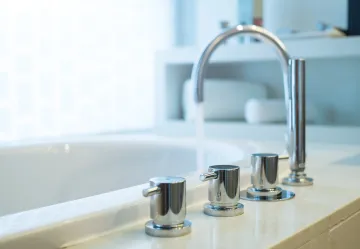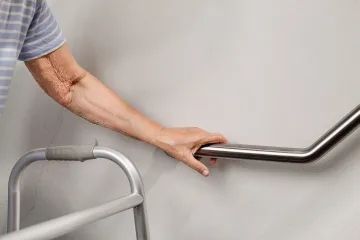From Mundane to Menacing: Practicing Bath Safety

From brushing our teeth to washing our hands to enjoying our morning shower, the bathroom is a staple of our lives. In fact, it’s so much a part of our daily routine that we probably don’t even think twice about it.
But this seemingly unthreatening room houses many, often not-so-apparent hazards. You may be in disbelief, but in fact, the bathroom is one of the most dangerous rooms in the home for more vulnerable members of the household namely, seniors and children. Bathrooms are full of burn and fall hazards that can potentially lead to long-term injury, or in the worst cases, even death.
A Roomful of Risks
Burns:
Many bathroom staples can cause burns, including hot water from the bathroom sink and tub, bathroom appliances, and even the water taps themselves.
On average, U.S. hospitals see nearly 5,000 tap-water related burn injures each year. 85% of these injuries affect children 15 or younger and older adults aged 65+, but the reality is that anyone can sustain a scald injury if they‘re not careful (1).
Falls:
According to a study conducted by the National Institute of Aging, a whopping 80% of falls among older adults take place in the bathroom, making it by far the most dangerous room in the house for this demographic.
Slippery surfaces are an obvious source of falls, but having to maneuver around the bathroom is another major hazard for older adults many of us don’t consider. In fact, surprisingly, most falls among older adults take place around the toilet area, not in the shower or tub. The average toilet is too low to the ground for many adults to get off and on comfortably, contributing to exertion and fall injuries.
Points of Prevention
Burns:
The secret to preventing hot water burns lies in a single household object: your hot water heater.
To prevent scald burns, The Consumer Product Safety Commission advises hot water heaters be set at a temperature no higher than 120? Fahrenheit.

For both electric and gas water heaters, start by contacting your local gas or electric company. Many companies will adjust the temperature free of charge, or if not, provide guidance on how to do it yourself.
For a step-by-step guide on how to safely adjust your water heater and check your water temperature yourself, check out: cultureofsafety.thesilverlining.com/childcare/tap-water-burns-and-scalds/.
While cooling down your water heater is a great first step, it’s not fail-proof. Especially if you have kids or older adults in your home, you should take additional precautions to prevent hot-water related burns:
- Fill up the sink or bathtub first instead of filling it with your loved one in the tub.
- Follow a pattern of cold, hot, cold. Initially filling the tub with cold water prevents burns if your child happens to come into contact with the tub, while ending with cold water cools off the faucet so the tap itself doesn’t cause burns.
- Monitor the tub while it fills to ensure older children don’t adjust the taps.
- Before placing children or allowing older relatives to get in the tub, test the water with your hand and stir it to break up any hot spots. If the water feels uncomfortably hot to you, it’s probably too hot for your loved one.
Last but certainly not least, beware of burns from electrical appliances around the bathroom. Curling and straightening irons, steamers and clothing irons, hairdryers, and other heat sources should be turned off and unplugged when not in use and never left unmonitored if there are children in the household. Furthermore, never use appliances near water, which can result in electric shock.
Falls:
Keeping bathrooms fall-free for older adults requires a few modifications to bathroom design and equipment. The name of the game is improving balance and minimizing obstacles that could cause loved ones to trip and fall.
- Help older adults (aged 65+) maintain their balance by installing well-anchored handles in the shower and near the toilet. If your loved one needs a little extra support, have a shower chair handy so they can sit while showering.
- Consider replacing your standard bathtub with a walk-in shower or tub, which are easier for older adults to maneuver in and out of. Similarly, consider switching out your toilet for a taller model that reduces the stress and imbalance mounting and dismounting the toilet can cause to older bodies.
- Pad bathroom, tub, and shower floors with non-slip mats to ward off injuries from wet floors.
- Keep your bathroom clean and well-organized. Clutter on the floor equals more obstacles for older adults to trip over.
In Case of Injury

Unfortunately, accidents do happen. If you or your loved one sustain a burn in the bathroom, remove all clothing from the affected area and run the burn under cool water. Wrap the burned area in clean, dry bandages and seek medical attention if necessary.
In the case of a loved one falling, ask them if they‘re experiencing any pain, and if so, where and how severe. Check them for any bruises, sprains, broken bones, or other injuries.
If injuries are minor, help the victim get up slowly. This step-by-step rundown is helpful in knowing how to safely help someone up after a fall: https://www.agingcare.com/articles/pick-up-a-senior-after-a-fall-170447.htm. If you start helping your loved one up and find they can’t support their own weight, seek medical attention immediately.
For more severe injuries, do not attempt to move your loved one. Instead, call 911 and make them as comfortable as possible until first responders arrive.
When in doubt, call 911. Even if injuries end up being relatively minor, first responders can help you get your loved one back on their feet after a fall without incurring any further damage. No matter the severity of the injuries, make sure to report the fall back to your loved one’s doctor and continue monitoring for injuries that may emerge after the fact.
Minor modifications can make a big difference when it comes to bathroom safety. Let’s make sure the bathroom remains the mundane place we‘ve come to know and rely on.

